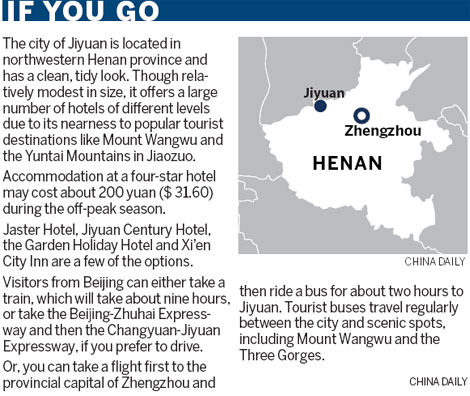A river runs through it
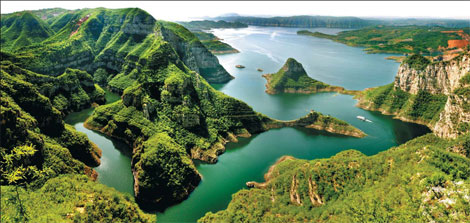 |
|
The landscapes along the Three Gorges of the Yellow River, with chains of mountains competing in beauty, are a rare blend of water and peaks. Photos Provided to China Daily |
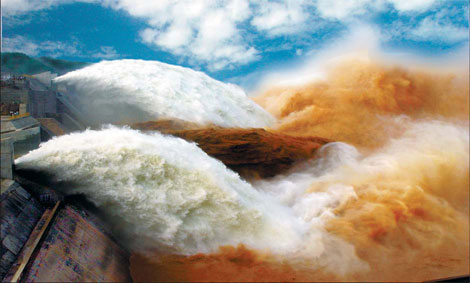 |
|
Tremendous fountains of water spurt from the valves of the Xiaolangdi hydro-junction on the Yellow River. |
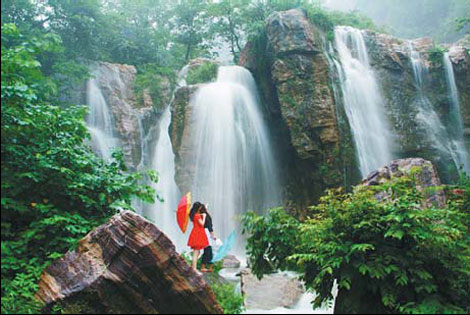 |
|
Mount Wangwu boasts various geological marvels like waterfalls. |
 |
|
Mount Wangwu is home to varied wildlife like macaques. |
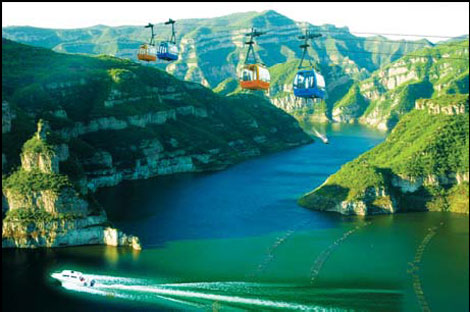 |
|
Visitors can take in the beautiful landscapes of the Three Gorges by riding funicular cars or boarding cruise ships. |
The Yellow River combines with Mount Taihang in Henan province to create a scenic setting for legends about the beginning of China. Liu Xiangrui and Chang Cheng report.
In western Jiyuan, Henan province, the alpine splendor of Mount Taihang and the mighty Yellow River combine to create a spectacular scene.
On a map, the 400-km Taihang range looks as if it is being hugged by the river near its southern tail, where Mount Wangwu stands.
To fully appreciate their beauty within a day, you will need a good night's rest the night before. This way, you can get up early enough to enjoy a splendid sunrise on Mount Wangwu, which gets its name from its peculiar shape - a grand bonnet on the emperor's chariot.
However, Wangwu is chiefly known these days from an ancient tale recounted by Chairman Mao Zedong.
According to the story, Yugong, or the foolish old man, wanted to remove two mountains, including Mount Wangwu, that were in front of his house and hindered fetching water.
Yugong led his family and neighbors to ceaselessly work at removing the mountains and, in the end, succeeded with the help of a god, who was moved by his tenacity.
Visitors who bear this legend in mind may see the wide break between two ridges as the place where Yugong tried to dig out the mountains.
Conquering the 1,715-meter summit, Tiantan Peak, is a physical challenge if you climb on foot and a mental one if you ride the funicular car that sways hundreds of meters in midair. But it's worth it.
Those who reach the summit find Mount Wangwu dwarfs all the rest for a majestic view.
Old stories say that Huangdi, the legendary ancestor of all Chinese, once offered sacrifices to heaven from Tiantan Peak and finally managed to unite the Middle Kingdom by defeating Chiyou, another legendary figure, with divine support.
Meanwhile, Mount Wangwu has held the top position among the "10 blessed paradises" in the Taoist world since the Tang Dynasty (AD 618- 907).
Many Taoist temples dot the mountain. Yangtai Palace, at the foot of Tiantan Peak, is the most famous. First built in the Tang Dynasty, the temple is just as much a work of art as it is a center for religion.
Its main hall, the pavilion-style Yuhuang Palace, impresses all, with its elegant stretching eaves, which resemble the wings of birds about to take flight. Carved on its stone pillars are lifelike images of people, animals and landscapes.
Mount Wangwu boasts various geological marvels and became a world geological park in 2006.
Volcanic rocks of strange shapes and various sizes in Xiaogoubei Valley bear witness to the region's transformation from ocean to mountain.
The multicolored rocks surrounding the site are known as "five-color rocks".
The tale of goddess Nuwa mending the broken sky with the "five-color rocks" is a Chinese version of the creation myth and is acknowledged as having its roots here. The legend is listed as a national intangible cultural heritage.
The Three Gorges on the Yellow River are about 20 km from Mount Wangwu and can be seen on a good day.
The landscapes along the gorges, with chains of mountains competing in beauty, are a rare blend of water and peaks, especially in North China. Each of the gorges has its own unique facets.
All you need to do is board a cruise ship at the dock and feast your eyes. As the ship barrels down the river, the waterway changes in width, height and color.
The Yellow River also reveals her peaceful side here. Birds sing, and sunbeams play over the mountains. It is like being in a landscape scroll painting.
The 20-km cruise will take you to another scenic splendor - the Xiaolangdi hydro-junction, the largest water-control project on the river.
The 1,667-meter-long rock-filled dam is not only a masterpiece of hydraulic engineering but also a spectacle that shows off the strength of the Yellow River.
It stands as a monument to Chinese people and their efforts to harness the river. Visitors who wish to check at close quarters can take a walk on the dam.
When the water is discharged, tremendous fountains spurt from the valves with a thunderous roar. Breathtaking waterfalls, dozens of meters high, then sweep down like thick clouds and engulf everything below.
Xitang, a small island spotted with village cottages, is located just 4 km downstream from the sluices. The only inhabited island on the 5,464-km-long Yellow River is certainly enchanting.
A walk around the farmhouses half hidden by leafy green trees will calm you down after the water show at Xiaolangdi.
Due to its unique location, the island is home to flocks of water birds, too. Strangely, perhaps, the island has never flooded.
As dusk falls, birds warble and boats return home, giving the place the feeling this is a "Peach Blossom Valley", a haven of perfect peace in Chinese romances.
